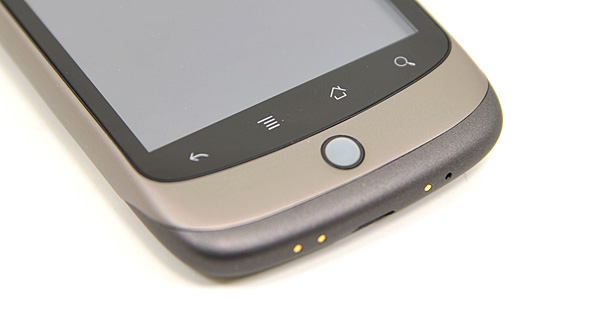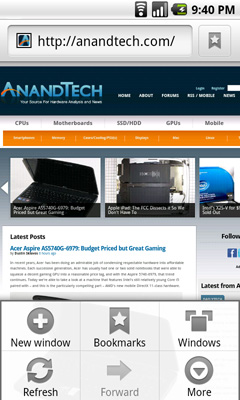Anand's Google Nexus One Review
by Anand Lal Shimpi on April 3, 2010 3:40 AM EST- Posted in
- Smartphones
- Mobile
The Home Bar
The Nexus One has three physical buttons: a power/lock button at the top, volume rocker on the left side and a trackball/button on the face.

The trackball is mostly useless. The Nexus One has a 3.7” multitouch screen for a reason, and it’s way quicker to use the screen than to use the trackpad for scrolling. There are some limited situations where the trackball can be useful, for example while playing games. The iPhone has no useful physical buttons for gaming, the Nexus One’s trackball is better for moving a character around than a virtual d-pad.
Above the trackball there are four touch buttons with fixed functions: back, menu, home and search. By default all provide haptic feedback when activated. In other words, they vibrate a bit when you touch them. It’s a fine feature but it’s nowhere near the feedback you get from physical buttons if that sort of thing matters to you. The buttons also give you the same feedback regardless of whether or not their operation is permitted in the current mode (e.g. hitting the contextual menu button when no such menu exists).
The back button is useful and works as intended, it goes back a screen. The menu button takes some getting used to. The best way I can describe it is like a right click. You get a contextual menu depending on what app you’re running. At the home screen it lets you pop into Android’s settings, add application shortcuts, change wallpaper, view notifications and search. In the email app the contextual menu lets you refresh your inbox, switch to a different folder, change settings, etc...

The contextual menu in Android's Browser app
This is where Android’s more PC-side comes out to play. Apple and Palm for the most part try to keep these sorts of menus away from you. Apps are purposefully not very deep and settings are all controlled through the settings screen, not from within an app. Functionality is driven by the UI. Android takes a more application centric approach. Neither is right or wrong, but both approaches have their pros and cons. I’d argue that Apple/Palm’s approach is better suited for something that’s going to be used as a passive device. Something you’re quickly scanning emails or text messages on. Google’s take is more PC-like. Give the users the options they want, where they want them, even at the risk of UI simplicity.
The Apple method runs the risk of limiting functionality, while Google’s risks turning the UI into a cumbersome mess. Neither is there today, but left unchecked that’s where they’d end up.
Moving on, the home button works as expected, it takes you to your home screen. The search button is particularly interesting because it is one Android feature that Microsoft copied in Windows Phone 7. Hitting the search button brings up an autocomplete enabled Google search box. Hitting go, launches the web browser (very quickly thanks to Mr. Snapdragon) and displays your search results.

What MS is proposing for WP7 are contextual search results that are formatted for the smartphone. Akin to a search app if you will. Search for GeForce GTX 480 and get a normal listing of websites. Search for dentists and get a smartphone formatted list of dentists in your area. Granted MS’ proposal is just that, a proposal, while Android is shipping today. Enabling similar functionality though shouldn’t be hard for Google. I’d love to be able to search, pull results from the web, but have the results presented as more of an app.

Windows Phone 7 Search
The search function will autocomplete things like address book entries, but it won’t automatically search your email for you. While the iPhone’s search function is more focused on searching your device, Android is more interested in helping you search the web. Google has a search engine, Apple doesn’t, the distinction makes sense.










95 Comments
View All Comments
strikeback03 - Tuesday, April 6, 2010 - link
So does a 2mm difference in width really make that much difference in how you hold it and keyboard feel? As both phones are quite large compared to my HTC Diamond.Anand Lal Shimpi - Tuesday, April 6, 2010 - link
It really has to do with the autocorrect on the keyboard and key spacing it seems. I switched back to the Nexus One today and definitely make more errors that I have to manually correct, whereas the iPhone seems to do a better job of knowing exactly what I'm trying to say/type.The performance and screen are very nice on the Nexus One however :)
Take care,
Anand
Locut0s - Sunday, April 4, 2010 - link
Thanks for the great review Anand!! I've been thinking of getting a smart phone for some time now and have been eyeing either a Nexus one or whatever Apple does with their next iteration of their iPhone. This review has placed the Nexus one squarely in my top 3. As always fantastic writing, thanks! However I should point something as a reader living outside the US. Google Voice is still not available in Canada or anywhere else outside the US. So if you are reading this review and that feature sounds nice keep this in mind!!Chloiber - Sunday, April 4, 2010 - link
If you like the Google Nexus, read some reviews about the coming (in the next days - weeks) HTC Desire - I bet you like it even more :)Zokudu - Sunday, April 4, 2010 - link
Wonderful article Anand.This epitomizes what I love about your writing.
Keep up the great work
Anand Lal Shimpi - Sunday, April 4, 2010 - link
Thank you :)Take care,
Anand
Mumrik - Sunday, April 4, 2010 - link
"Most of the time you all scare the crap out of me. I want to impress, I want you guys to be happy with what I write. I want every article to be the most well received thing ever. Every writer wants that. No one ever gets it. So when I see comments telling me that you’re eagerly anticipating my Nexus One review, I get a turtle complex. And not the ninja kind."I don't think you need to worry too much about all that Anand. Your work over the last few years especially has been top-of-the-class.
Lifedelinquent - Sunday, April 4, 2010 - link
wonder if the htc evo will use the more updated snapdragon proc with the better gpu?Chloiber - Sunday, April 4, 2010 - link
It will use the Snapdragon QSD8650 (N1/Desire: QSD8250) with 1GHz.http://www.engadget.com/2010/03/23/htc-evo-4g-is-s...
Don't know what that implies about the built in GPU though.
LongTimePCUser - Sunday, April 4, 2010 - link
Anand,It sounds like your biggest problem with the Google phone was the on-screen keyboard.
Have you tried the slide-out keyboard on the Motorola Droid?
The big advantage is that you can see the entire display screen, including type-ahead suggestions, while typing.